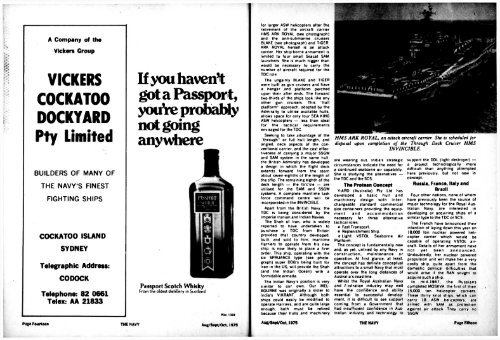The Navy Vol_37_Part2 (Aug-Sep-Oct, Nov-Dec 1975-Jan 1976)
The Navy Vol_37_Part2 (Aug-Sep-Oct, Nov-Dec 1975-Jan 1976)
The Navy Vol_37_Part2 (Aug-Sep-Oct, Nov-Dec 1975-Jan 1976)
Create successful ePaper yourself
Turn your PDF publications into a flip-book with our unique Google optimized e-Paper software.
A Company of the<br />
Vickers Group<br />
VICKERS<br />
COCKATOO<br />
DOCKYARD<br />
Pty Limited<br />
BUILDERS OF MANY OF<br />
THE NAVY'S FINEST<br />
FIGHTING SHIPS<br />
COCKATOO ISLAND<br />
SYDNEY<br />
Telegraphic Address:<br />
CODOCK<br />
Telephone: 82 0661<br />
Telex: AA 21833<br />
If you haven't<br />
got a Passport,<br />
you're probably<br />
not going<br />
anywhere<br />
Passport Scotch Whisky<br />
From tne oldest distillery in Scotland<br />
904.1028<br />
for larger ASW helicopters after {he<br />
retirement of the aircraft carrier<br />
HMS ARK ROYAL (see photograph)<br />
and the anti-submarine cruisers<br />
BLAKE (see photograph) and TIGER.<br />
ARK ROYAL herself is an attack<br />
carrier. Her ship-borne armament is<br />
limited to four small Seacat SAM<br />
launchers. She is much bigger than<br />
would be necessary to carry the<br />
number of aircraft required for the<br />
TDC role.<br />
<strong>The</strong> ungainly BLAKE and TIGER<br />
were built as gun cruisers and have<br />
a hangar .and platform perched<br />
upon their after ends. <strong>The</strong> forward<br />
two-thirds of the ships look like any<br />
other gun cruisers. This 'half<br />
platform" approach, adopted by the<br />
Admiralty to utilise available hulls,<br />
allows space for only four SEA KING<br />
ASW helicopters — less than ideal<br />
for the tactical requirements<br />
envisaged for the TDC.<br />
Seeking to take advantage of the<br />
"through" or full hull length, and<br />
angled, deck aspects of the conventional<br />
carrier, and the cost effectiveness<br />
of carrying a major SSGW<br />
and SAM system in the same hull,<br />
the British Admiralty has developed<br />
a design in which the flight deck<br />
extends forward from the stern<br />
about seven-eighths of the length of<br />
the sHip <strong>The</strong> remaining eighth of the<br />
deck length — the fo'c'sle — are<br />
utilised for the SAM and SSGW<br />
systems. A complete maritime task<br />
force command centre will be<br />
incorporated in the INVINCIBLE.<br />
Apart from the British <strong>Navy</strong>, the<br />
TDC is being considered by the<br />
Imperial Iranian and Indian Navies.<br />
<strong>The</strong> Shah of Iran, who is widely<br />
reported to have undertaken to<br />
purchase a TDC from Britain<br />
provided that country developed,<br />
built, and sold to him. maritime<br />
Harriers to operate from his new<br />
ship, is now likely to place a firm<br />
order. This ship, operating with the<br />
six SPRUANCE type (see photograph)<br />
super DDG's being built for<br />
Iran in the US. will provide the Shah<br />
(and the Indian Ocean) with a<br />
formidable armada.<br />
<strong>The</strong> Indian <strong>Navy</strong>'s position is very<br />
similar to our own. Our MEL-<br />
BOURNE was originally a sister to<br />
India's VIKRANT. Although both<br />
ships could easily be modified to<br />
operate Harriers, and are quite large<br />
enough, both must be retired<br />
because their hulls and machinery<br />
HMS ARK ROYAL, an attack aircrajt carrier. She is scheduled Jor<br />
disposal upon completion oj the Through <strong>Dec</strong>k Cruiser HMS<br />
INVINCIBLE.<br />
are wearing out. India's strategic<br />
circumstances indicate the need for<br />
a continued seaborne air capability.<br />
She is studying the alternatives —<br />
the TDC and the SCS.<br />
<strong>The</strong> Protean Concept<br />
Y ARD (Australia) Pty Ltd has<br />
developed a basic hull and<br />
machinery design with interchangeable<br />
standard commercial<br />
size containers providing the equipment<br />
and accommodation<br />
necessary for three alternative<br />
tactical roles:<br />
e Fast Transport,<br />
e Replenishment Ship,<br />
e Light VSTOL Seaborne Air<br />
Platform.<br />
<strong>The</strong> concept is fundamentally new<br />
and. as yet, untried by any <strong>Navy</strong> in<br />
construction, maintenance or<br />
operation. At first glance, at least,<br />
the concept has definite conceptual<br />
attractions to a small <strong>Navy</strong> that must<br />
operate over the long distances of<br />
Australia's coastline.<br />
Whilst the Royal Australian <strong>Navy</strong><br />
and t istralian industry may well<br />
have the confidence and ability<br />
essential to successful development.<br />
it is difficult to see support<br />
coming from a Government that<br />
had insufficient confidence in Australian<br />
industry and technology to<br />
support the DDL (light destroyer) —.<br />
a project technologically more<br />
difficult than anything attempted<br />
here previously, but not new in<br />
concept.<br />
Russia, France, Italy and<br />
Brazil<br />
Four other nations, none of whom<br />
have previously been the source of<br />
major technology for the Royal Australian<br />
<strong>Navy</strong>, are interested in<br />
developing or acquiring ships of a<br />
similar type to the TDC or SCS.<br />
<strong>The</strong> French have Announced their<br />
intention of laying down this year an<br />
18.000 ton nuclear powered helicopter<br />
carrier which would be<br />
capable of operating VSTOL aircraft.<br />
Details of her armament have<br />
not yet been announced.<br />
Undoubtedly, her nuclear powered<br />
propulsion unit will make her a very<br />
costly ship, quite apart from the<br />
domestic political difficulties that<br />
would arise if the RAN sought to<br />
acquire such a ship.<br />
In mid-1967, the Russians<br />
completed MOSKVA, the first of their<br />
15.000 ton helicopter carriers.<br />
<strong>The</strong>se thirty knot ships, which can<br />
carry 18 ASW helicopters, are<br />
armed with SAM as protection<br />
against air attack. <strong>The</strong>y carry no<br />
SSGW.<br />
Page Fourteen<br />
THE NAVY<br />
<strong>Aug</strong>/<strong>Sep</strong>V<strong>Oct</strong>, <strong>1975</strong><br />
<strong>Aug</strong>/<strong>Sep</strong>t/<strong>Oct</strong>, <strong>1975</strong> THE NAVY Page Fifteen

















